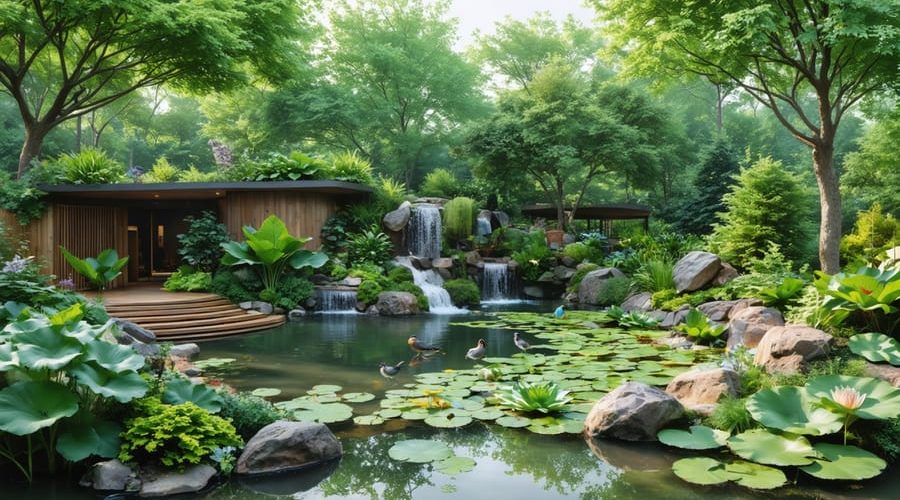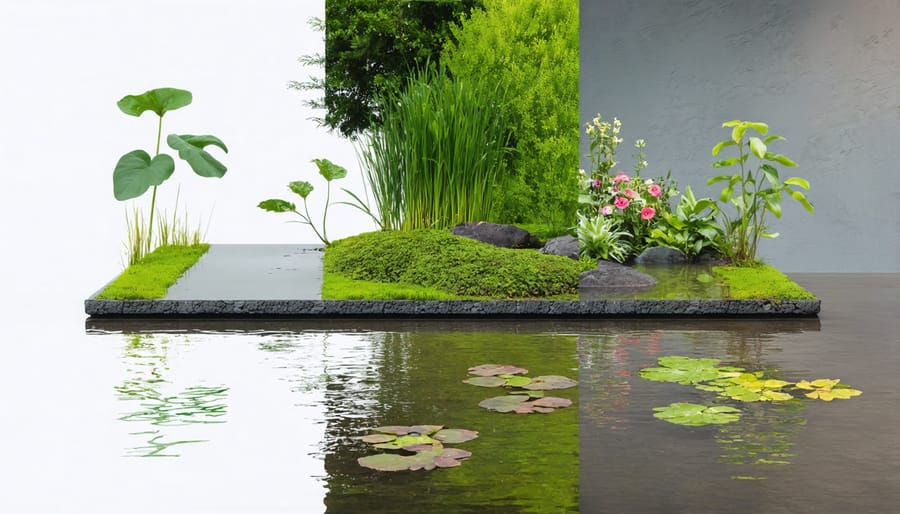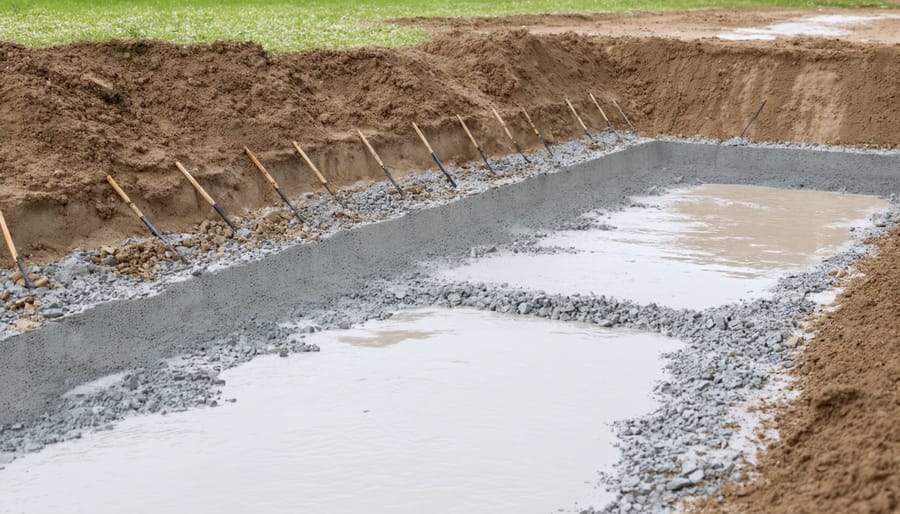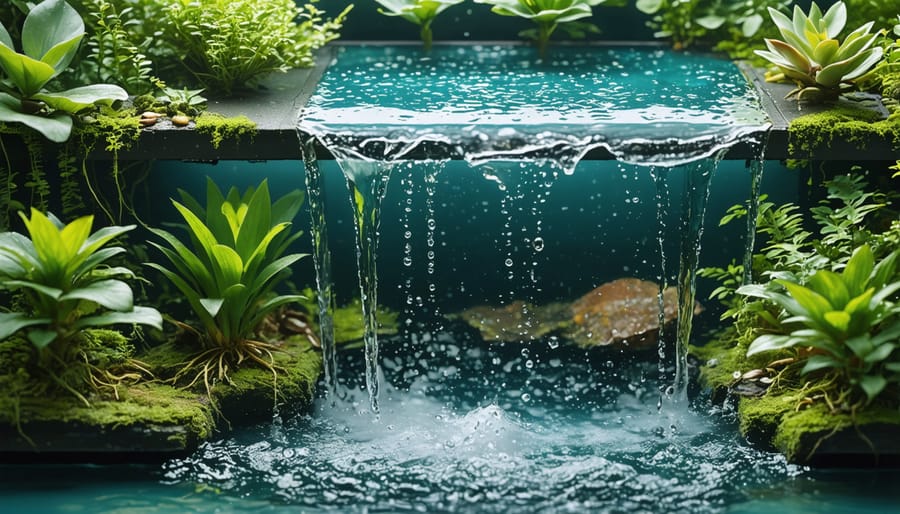
Transform Your Backyard With Natural, Earth-Friendly Pond Materials
Transform your backyard into a natural sanctuary with an eco pond – a self-sustaining water feature that works in harmony with nature. Unlike traditional pools, eco ponds use native plants, beneficial bacteria, and natural filtration to create a thriving pond ecosystem that requires minimal maintenance and zero harsh chemicals. These sustainable water gardens not only provide a haven for local wildlife but also help conserve water through natural cycles. Whether you’re a seasoned gardener or just starting your outdoor journey, creating an eco pond offers a perfect blend of environmental stewardship and stunning natural beauty. By choosing sustainable materials and following nature’s blueprint, you’ll create a living landscape feature that enriches your outdoor space while supporting local biodiversity.
Why Choose Eco-Friendly Pond Materials?
Environmental Impact
Traditional pond materials can have significant environmental drawbacks that many pond owners might not realize. Concrete liners, while durable, require extensive manufacturing processes that produce high carbon emissions. They also create an artificial barrier that prevents beneficial interaction between pond water and surrounding soil ecosystems. Plastic liners, commonly used in backyard ponds, are typically made from PVC or other synthetic materials that don’t biodegrade and can leach chemicals into the water over time.
Many conventional pond treatments and chemicals used for maintenance can harm local wildlife, beneficial bacteria, and aquatic plants. These substances often find their way into groundwater systems, affecting the broader environment. Additionally, traditional pumps and filtration systems tend to be energy-intensive, contributing to higher electricity consumption and increased carbon footprint.
The good news is that eco-friendly alternatives are becoming more widely available, offering solutions that work in harmony with nature rather than against it.

Cost Benefits
While the initial investment in eco-friendly pond materials might be slightly higher, the long-term benefits far outweigh the costs. These natural pond solutions typically last longer than conventional materials, reducing replacement and maintenance expenses over time. For example, natural stone liners can last decades compared to synthetic alternatives that may need replacement every 5-10 years.
Energy-efficient pumps and filtration systems can cut electricity costs by up to 50%, while native plants reduce the need for chemical treatments and expensive water additives. Many eco-friendly materials, like recycled rubber edging and sustainable wood, are becoming more affordable as demand increases. Plus, these materials often qualify for environmental incentives or rebates in certain regions.
By creating a balanced ecosystem, you’ll spend less on maintenance and enjoy lower water bills thanks to reduced evaporation and better water retention. It’s a win-win for both your wallet and the environment!
Natural Liner Alternatives
Bentonite Clay
Bentonite clay offers a natural and environmentally friendly solution for sealing your pond. This remarkable material has been used for centuries and works by expanding up to 15 times its size when wet, creating an exceptionally effective water barrier. When properly applied, it forms a thick, impermeable layer that prevents water from seeping into the ground.
To use bentonite clay, start by calculating the area you need to cover. You’ll typically need about 6-8 pounds of clay per square yard for effective sealing. Spread the dry clay evenly across your pond base and sides, then dampen it slightly. The clay will begin to swell and form a tight seal. Some pond builders prefer to mix the clay with the existing soil for better integration.
One of the best aspects of bentonite clay is its self-healing properties. If small cracks develop, the clay will naturally expand when exposed to water, automatically sealing any leaks. This makes it an excellent long-term solution for eco-conscious pond owners.
While bentonite clay might cost more initially than synthetic liners, its durability and environmental benefits make it a worthwhile investment. It’s completely natural, non-toxic, and won’t harm plants or wildlife. Plus, it integrates seamlessly with the surrounding ecosystem, allowing beneficial bacteria and microorganisms to thrive.

Recycled EPDM Liners
EPDM rubber liners made from recycled materials are an excellent eco-friendly choice for pond construction. These liners give new life to used rubber products, primarily recycled tires and roofing materials, reducing landfill waste while creating durable pond barriers. The recycling process involves breaking down the rubber into small particles, which are then reformed into flexible, waterproof sheets perfect for pond applications.
What makes recycled EPDM particularly appealing is its impressive 20+ year lifespan and resistance to UV rays, making it a long-lasting solution that won’t need frequent replacement. The material remains flexible even in extreme temperatures, making installation easier for DIY enthusiasts. It’s also fish-safe and won’t leach harmful chemicals into your pond water.
When shopping for recycled EPDM liners, look for products certified by environmental organizations and those with a high percentage of recycled content. While they might cost slightly more than traditional liners initially, their durability and eco-friendly properties make them a worthwhile investment.
Installation is straightforward – the liner is flexible enough to conform to your pond’s shape, and most manufacturers provide detailed guidelines. Remember to use an underlayment to protect the liner from sharp objects in the soil. Many recycled EPDM products come with warranties, giving you peace of mind about your sustainable choice.
Sustainable Edge Materials
Local Stone Options
Using local stones in your eco pond not only creates a natural look but also reduces the environmental impact of transporting materials from far away. Take a walk around your property or visit nearby quarries to source rocks that naturally occur in your area. These stones will blend seamlessly with the local landscape and provide familiar habitat for native wildlife.
When collecting stones, look for a mix of sizes – from large boulders for dramatic focal points to smaller rocks for edging and detail work. Flat stones work wonderfully for creating shallow shelves and natural-looking waterfalls, while rounded rocks can soften edges and create gentle transitions between water and land.
Before placing stones in your pond, clean them thoroughly with plain water (avoid soap or chemicals) and check for sharp edges that could damage pond liner. Layer stones carefully, starting with larger ones at the bottom and working up to smaller pieces. This creates stable foundations and prevents shifting over time.
Consider incorporating local slate, granite, or limestone, depending on what’s abundant in your region. These materials often weather beautifully and can host beneficial microorganisms that help maintain pond health. Remember to check local regulations about collecting stones, and always obtain materials from legitimate sources.
Recycled Materials
Creating an eco-friendly pond doesn’t mean starting from scratch with new materials. In fact, some of the best pond features can come from items you might already have lying around. Old bathtubs make excellent small ponds, while large wooden cable spools can be transformed into raised pond features. Large plastic containers, like food-grade barrels or old water tanks, are perfect for creating water gardens.
Consider using reclaimed stones and bricks for edging your pond or building waterfalls. These materials often come with natural weathering that adds character to your design. Old ceramic pots can be repurposed as plant holders or broken down to create unique mosaic decorations around your pond’s edge.
For filtration systems, plastic drums and buckets can be converted into efficient bio-filters. Glass bottles can be artfully arranged to create colorful borders or underwater features that catch the light. Even old pipes and guttering can find new life as water channels or decorative waterfalls.
Remember to thoroughly clean any recycled materials before using them in your pond, and avoid items that might have contained harmful chemicals. When sourcing materials, check local construction sites, salvage yards, and online marketplaces – you’ll be surprised at what treasures you can find!
Natural Filtration Systems
Plant-Based Filters
Natural pond plants are nature’s own water purification system, making them an essential component of any eco-friendly pond. These aquatic plants work tirelessly to filter water through their roots, removing excess nutrients and harmful compounds that could otherwise lead to algae blooms.
Water lilies and floating plants provide shade, reducing water temperature and algae growth while oxygenating the water. Marginal plants like rushes and iris not only look stunning but also trap sediment and filter pollutants through their extensive root systems. Submerged plants such as hornwort act as natural filters below the surface, absorbing nitrates and providing shelter for beneficial microorganisms.
Creating a plant-based filtration system is surprisingly simple. Start by incorporating a mix of different plant types: floating, marginal, and submerged varieties. Place them strategically around your pond, focusing on areas where water enters and exits. For best results, aim to cover about 60% of your pond’s surface with plants.
Remember to choose native species when possible, as they’re already adapted to your local climate and provide additional benefits for local wildlife. Regular maintenance is minimal – just trim back excessive growth and remove dead foliage to prevent decomposition in the water.

Biological Filter Media
Biological filter media plays a crucial role in maintaining a healthy eco pond by providing a home for beneficial bacteria that break down waste. Natural materials like lava rock, bio balls, and ceramic rings offer excellent surfaces for bacterial colonization while staying true to eco-friendly principles.
Lava rock is a fantastic choice because its porous surface creates countless tiny spaces where beneficial bacteria can thrive. It’s completely natural, long-lasting, and helps maintain stable water chemistry. Plus, it’s readily available and budget-friendly!
Another great option is crushed oyster shells, which not only support bacterial growth but also help buffer your pond’s pH levels naturally. For those seeking lightweight alternatives, coconut fiber (coir) makes an excellent biological filter medium. It’s sustainable, biodegradable, and extremely effective at trapping debris while hosting beneficial microorganisms.
Remember to layer your filter media from coarse to fine materials. Start with larger pieces like lava rock at the bottom, followed by medium-sized materials like bio balls, and finish with finer media on top. This creates an efficient filtration system that’s easy to maintain and clean.
To keep your biological filter working at its best, avoid cleaning all the media at once – this preserves some of the beneficial bacteria colony. A gentle rinse in pond water (not tap water) every few months is usually sufficient to maintain optimal performance.
Maintenance Tips
Maintaining an eco-friendly pond doesn’t have to be complicated. By following these water sustainability strategies, you can keep your pond thriving while minimizing its environmental impact.
Regular monitoring is key – check water quality weekly using test strips to ensure proper pH levels and oxygen content. Remove fallen leaves and debris promptly to prevent excess nutrient buildup, which can lead to algae problems. A simple pond net makes this task quick and easy.
Keep your beneficial plants healthy by trimming dead foliage and dividing them when they become overcrowded, typically every 2-3 years. This maintains the natural filtering system and ensures optimal nutrient absorption. Remember to compost the trimmings for use in your garden.
For your pond’s ecosystem to flourish, maintain proper water levels, especially during dry spells. Consider installing a rain barrel to collect rainwater for top-ups instead of using treated tap water. This saves money and is better for your aquatic life.
Clean your pump and filters regularly, but avoid harsh chemicals. Instead, use biological filter media and rinse it in a bucket of pond water to preserve beneficial bacteria. If algae become an issue, try adding more floating plants for shade rather than reaching for chemical solutions.
Finally, observe your pond’s seasonal changes and adjust maintenance accordingly. Spring and fall typically require more attention, while summer and winter need minimal intervention. This natural approach helps create a self-sustaining ecosystem that’s both beautiful and environmentally responsible.
Creating an eco-friendly pond is more than just a trendy choice – it’s a meaningful step toward environmental stewardship that brings multiple rewards. By choosing sustainable materials and natural filtration methods, you’re not only creating a beautiful water feature but also supporting local wildlife and reducing your environmental impact.
The benefits of eco ponds extend far beyond their visual appeal. They help conserve water through natural circulation systems, create valuable habitats for local wildlife, and require fewer chemical treatments than traditional ponds. The reduced maintenance needs save both time and money while contributing to a healthier ecosystem in your backyard.
Remember that every sustainable choice matters, no matter how small. Whether you’re starting from scratch or converting an existing pond, implementing eco-friendly practices can make a significant difference. Consider starting with simple steps like adding native plants or installing a solar pump, then gradually expanding your pond’s eco-friendly features as you become more comfortable with maintenance.
By choosing to create or maintain an eco pond, you’re joining a growing community of environmentally conscious gardeners who understand that beautiful outdoor spaces and environmental responsibility can go hand in hand. Take that first step today – your garden, local wildlife, and the planet will thank you for it.
